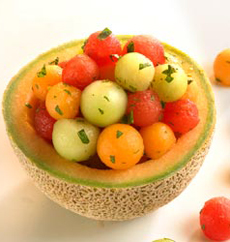TIP OF THE DAY: Drunken Fruit #2 – Marinated In Wine Or Champagne
|
May 13th is National Fruit Cocktail Day. How about an easy “drunken fruit” dessert. You can use winter fruits or summer fruits. More delicate summer fruits do best with a white wine marinade; winter fruits such as citrus and grapes can use either white or red. You can do all of the prep work in advance and let the fruit marinate in the wine—overnight, if you like. For Champagne, make an impression by pouring it into the bowls at the table. This also preserves the bubbles. For kids and non-drinkers, use ginger ale. 1. USE a melon baller to scoop melon balls. 2. FILL wine goblets to 1″ of top with melon balls. Add wine. 3. GARNISH and serve with forks. Here’s an even easier drunken fruit dessert recipe. White dessert wines include Ice Wine, Moscato d’Asti, Muscat and Sauternes. You can also use a sweet sparkling wine, such as a demi-sec, doux or sec Champagne (see the styles below). It’s counter-intuitive, but “sec,” which means dry in French, refers to sweeter Champagnes. Brut designates a dry Champagne or cider. Sec Champagnes are sweeter than demi-sec. |
|
|
|
THE DRYNESS OR SWEETNESS LEVELS OF CHAMPAGNE Dry Champagnes are meant to be drunk with savory foods. Sweet Champagnes are dessert wines. Either dry or sweet can be served as an apéritif. Here’s how the sugar levels compare. The higher the percentage, the sweeter the Champagne.
|
||




